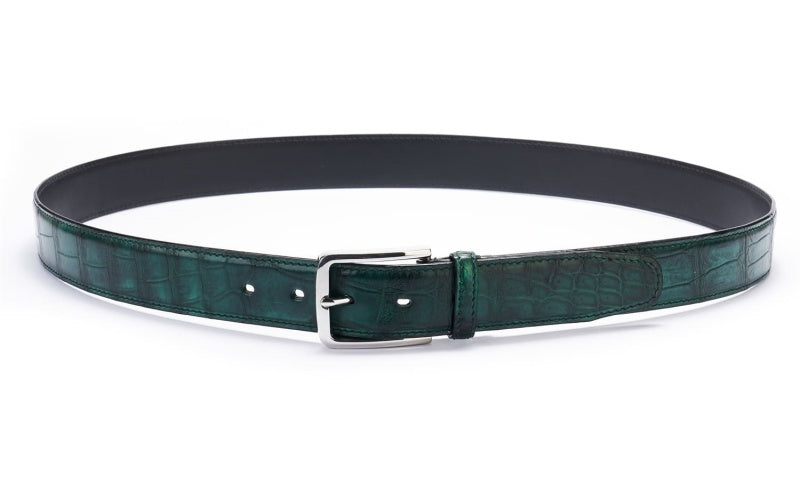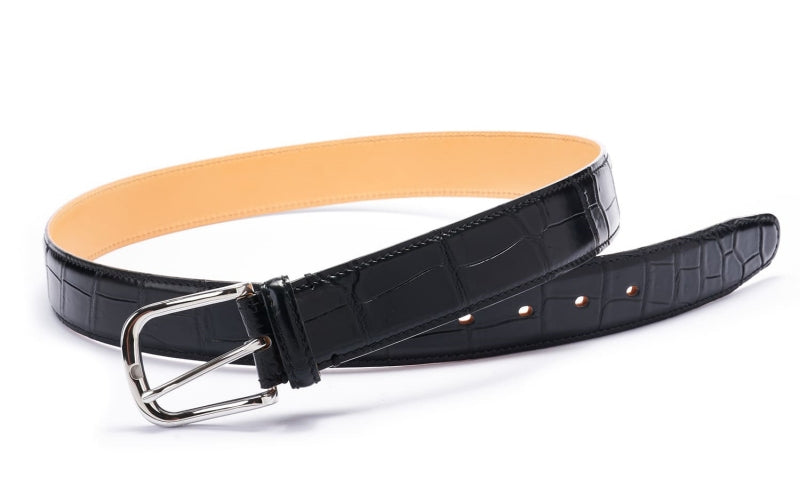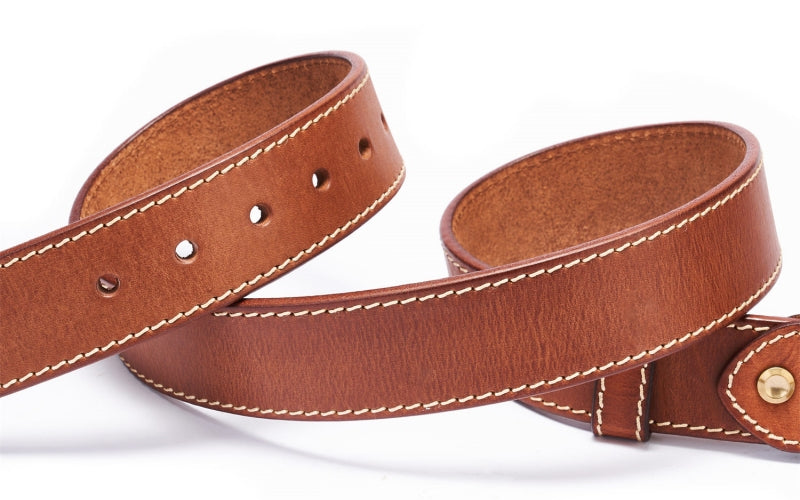
Alligator vs Crocodile Belts: Which Scaly Luxury Deserves Your Wallet?
Let’s kick things off with a confession: I once spent 45 minutes debating between an alligator belt and a crocodile belt. My friends laughed. My dog judged me. But here’s the thing—when you’re investing in a luxury accessory that could cost more than your monthly car payment, you need to overthink.
Is alligator leather really smoother? Do crocodile scales last longer? And why does no one talk about how both these creatures look like they’re permanently side-eyeing humanity?
Buckle up (literally), because we’re diving into the wild world of exotic leather belts. Spoiler: By the end, you’ll know your tegument from your tannins—and maybe even impress a herpetologist at your next dinner party.
1. Alligator vs Crocodile 101: Spotting the Difference (Without Getting Chomped)
First rule of exotic leather club: Never call an alligator belt “crocodile” in front of a fashion snob. The differences are subtle but mighty important.
A. Scale Patterns: Nature’s Fingerprint
-
Alligator: Picture tiny, symmetrical bubbles. Their scales are smoother, with a “porthole” pattern around the belly (the primo leather source). It’s like the reptile version of a perfectly frosted cake.
-
Crocodile: Think jagged, irregular scales with visible “dots” (salt glands) along the sides. Croc leather has a grittier, textured vibe—like the cool, edgy cousin at a family reunion.
B. Skin Texture: Touch Test
Run your finger over an alligator belt—it’ll feel buttery, almost like suede. Crocodile? It’s got more grip, like the leather equivalent of a hiking boot.
C. Geography Lesson
-
Alligators: Mostly found in the southern U.S. and China. Fun fact: Louisiana supplies 90% of the world’s alligator leather. Laissez les bons temps rouler!
-
Crocodiles: Global gangsters. Nile crocs in Africa, saltwater crocs in Australia, and the rare Siamese croc in Asia.
Pro tip: If the salesperson says, “This is caiman leather,” they’re talking alligator’s smaller, budget-friendly cousin. Great for starters, but not the VIP section.
2. Why Exotic Leather Belts Cost More Than Your Last Vacation
Let’s address the elephant (or reptile) in the room: A premium alligator belt can run you $1,000–$3,000. Crocodile? Even pricier, especially for rare species. Here’s why:
A. Farming Drama
Raising these moody reptiles isn’t like herding cows. Gators need climate-controlled ponds, a diet of premium fish, and zero stress (stress = skin blemishes). Crocodile farms in Australia even play classical music to keep them chill. No, really.
B. The Tanning Tango
Exotic leather isn’t tossed into a vat of chemicals. It’s hand-tanned using techniques older than your grandma’s meatloaf recipe. Italian tanneries like Bonaudo spend weeks dyeing and polishing each hide to that signature glossy finish.
C. Waste Not, Want Not
Only 30-40% of a hide is “Grade A” (no scratches, bug bites, or love handles). The rest becomes watch straps, wallets, or that keychain your dad “loses” annually.
Fun analogy: Buying an exotic belt is like purchasing a Picasso. You’re not paying for paint—you’re paying for the story.
3. Durability Showdown: Will This Belt Outlive Your Cat?
My Aunt Linda has a 25-year-old alligator belt that’s survived two divorces and a house fire. Here’s how these leathers stack up:
|
Factor |
Alligator |
Crocodile |
|
Flexibility |
Softer, breaks in faster |
Stiffer, holds shape longer |
|
Scratch Resistance |
Prone to surface marks |
Tough as nails (literally) |
|
Water Tolerance |
Avoid pools & monsoons |
Laughs at spilled martinis |
Verdict: Crocodile belts are the Jeep Wranglers of accessories—rugged, low-maintenance, and ready for adventure. Alligator? More like a vintage Rolls-Royce: luxurious, but park it in the shade.
4. Style Wars: When to Rock Gator vs When to Go Croc
Alligator Belts Are For:
-
Black-tie weddings (pair with a tuxedo—chef’s kiss)
-
Subtle flexing at the office (match with Oxford shoes)
-
People who own more than one monogrammed towel
Crocodile Belts Are For:
-
Date nights (that texture screams “mystery”)
-
Rocking with denim and a leather jacket
-
Anyone who’s ever said, “I don’t need instructions”
Celeb Intel:
-
Alligator fans: George Clooney, Meghan Markle
-
Croc crew: David Beckham, Rihanna
5. Ethics Unzipped: How to Buy Exotic Leather Without Guilt
I get it—wearing a dead reptile isn’t everyone’s jam. But here’s the twist: Legal exotic leather trade protects these species.
A. CITES Certificates 101
Every Beltley exotic belt comes with a CITES (Convention on International Trade) permit. This ensures:
-
The animal wasn’t poached.
-
Farms meet strict welfare standards.
-
Profits fund conservation (Florida’s gator comeback? Thank legal farming).
B. The Vegan Leather Debate
“But what about pineapple leather?!” Look, if you want a belt that biodegrades in 3 months, go for it. But for heirloom quality, exotic leather reigns.
Hot take: Crocodile farming in Australia has saved saltwater crocs from extinction. Fashion can be eco-friendly.
6. Care Tips: Keep Your Belt from Going Extinct
Do:
-
Wipe with a damp cloth after wearing.
-
Store flat in a dust bag (not rolled up like a burrito).
-
Condition 2x/year with Saphir Reptan (it’s like Botox for leather).
Don’t:
-
Expose to perfume, sunscreen, or your toddler’s sticky hands.
-
Wear it to your CrossFit class (sweat = leather’s nemesis).
-
Try to “buff out” scratches yourself. Call a pro.
True story: A client once used coconut oil on his croc belt. It now resembles a greasy pizza box. Don’t be that guy.
7. The Investment Angle: Will This Belt Pay for Your Kid’s College?
High-end exotic belts appreciate if you play your cards right:
-
Limited editions (e.g., Hermès Nile croc) gain 5-7% yearly.
-
Vintage 1980s Gucci gator belts are auction gold.
-
Proper care = 50+ year lifespan.
Pro move: Buy a reversible alligator belt (black/brown). Two looks, one investment.
8. The Final Word: Which Reptile Are You?
Still stuck? Take this quiz:
-
Your Friday night involves…
a) Opera and champagne
b) Bonfires and bourbon -
Your style icon is…
a) James Bond
b) Indiana Jones -
You’d rather…
a) Discuss wine vintages
b) Plan a safari
Mostly A’s: You’re an alligator—polished, timeless, luxe.
Mostly B’s: You’re crocodile—bold, adventurous, unapologetic.
Final Thought:
Whether you choose gator or croc, you’re not just buying a belt—you’re adopting a legacy. Treat it well, and it’ll outshine every accessory you own. And hey, if anyone questions your choice, just smirk and say, “It’s protected species.” (Wink.)








